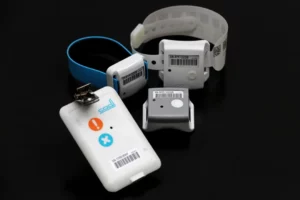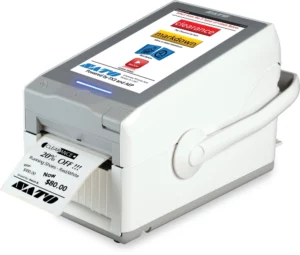The RFID technology has been successfully used in numerous industries such as agriculture, transportation, retail, manufacturing, and in the different phases of the supply chain, and it has also had an impact on the healthcare industry.
By delivering real-time tracking, authentication, communication, and location information for both individuals and resources, RFID for healthcare has the promise to save healthcare practices considerable time and money.
If you are in charge of a hospital, clinic, or any other type of medical facility, you are probably intimately familiar with the difficulties in providing top-notch treatment while maintaining patient safety and adhering to all applicable regulations.
An RFID solution offers an effective, affordable information system to promote best practices in patient treatment, from visits and admissions to points-of-care and into tracking inventory and supplies.
For the finest RFID software, tags, printers, and readers for your healthcare-related activities, turn to Makamat’s 14+ years of expertise.
What is RFID?
RFID (Radio-Frequency Identification) is a contactless solution that uses radio waves to transport data from an electronic tag affixed to an object to a reader. RFID for healthcare offers a method for managing and identifying equipment, materials, and even patients’ information, and we’ll get into that shortly.
Check out this article to dive into more details about RFID!
Why Use RFID for Healthcare?
Public health is greatly impacted by medical errors, which are the third leading cause of death (in the United States of America). Other significant industry problems include a lack of data and transparency, patient tracking, lengthy hospital wait times, inventory management, prescription mistakes, and parking management. By automatically recognizing and monitoring RFID tags attached to items, RFID offers a variety of solutions to these issues.
The healthcare industry is aware of how important it is to adopt and utilize health-related information technology. RFID has several prospects for the reformation of healthcare, with powerful institutional forces and regulations advocating for the implementation of these technologies to better enhance patient experiences.
The healthcare sector has access to a wide range of opportunities thanks to RFID’s ability to track hundreds of products simultaneously and identify each one of them individually beyond just the sort of product that each is.
To track patients, find equipment, and speed up care, healthcare organizations use RFID-enabled technologies, namely real-time location systems.
RFID helps in:
- Reducing medicine fraud
- Streamlining clinical trial procedures
- Increasing the precision of patient identification
- Reducing misidentification issues in healthcare
- Eliminating the chance of giving the wrong medication to patients through streamlining patient tracking, streamlining inventory management, and improving caregiver-patient communication.
RFID for Healthcare Asset Tracking
The healthcare industry loses millions of dollars annually due to the displacement and underuse of physical assets. It is a challenge to keep track of equipment, especially in major hospitals, which are sometimes vast, multi-floored facilities with over 10,000 properties. Personnel spend a lot of time and walk distances looking for underutilized devices or out-of-service equipment.
The reliability of operational processes can be significantly enhanced by increasing visibility of where key equipment is located. Applying RFID tags on all essential items makes it possible to trace every component used during procedures, allowing hospitals to reliably track allocation for every operation and guarantee reliable inventory restocking.
The perks of RFID for healthcare asset tracking can be summed up as such:
- Reliable inventory of medical resources
- Complete asset management repository integration
- Inventory record updates take minutes rather than hours.
- Enhanced patient safety through more frequent maintenance inspections
- Improved asset utilization implies substantially decreased capital expenditure
- Save clinical staff’s time
- Release capital constrained by surplus stock
- Reduce waste
- Monitor the use of inventories for every operation
RFID for Healthcare Patient Tracking
Identifying patients incorrectly can lead to medical errors, which is arguably the worst case situation. You need a method for your team to promptly and precisely confirm they are dealing with the proper patient if you want to eradicate these mistakes. The answer originates with admission.
Every patient obtains an RFID tag or wristband that contains all relevant demographic information as well as their medical history upon registration at the hospital or healthcare facility. All authorized healthcare practitioners will have access to this information, after it has been transferred into a computerized medical file.
The majority of patients receive care in a variety of locations throughout the hospital, including rehabilitation units, image processing rooms, and their bedsides.
In order to ensure that the proper individual is receiving medical care and that samples are documented appropriately, the staff members carrying out the examination or administering the medications can scan the patient’s RFID wristband at each stage of care and cross-reference the details with the information on the prescription. RFID for healthcare’s precision almost eliminates the possibility of inaccuracy.
The ability to track patients using RFID wristbands is yet another security measure. This tracking feature of RFID for healthcare may be crucial in situations where patients with dementia traipse into risky areas or leave the hospital, when doctors are making the rounds when it is time for an assessment or intervention, or even to remove the risk of infants being abducted from the hospital.
RFID for Healthcare Infant Safety
While health officials believe that Code Pink — the code term for infant abductions — is a rare occurrence in medical facilities, it is nevertheless a concern that must be addressed thoroughly by a hospital. There have been many instances of NICU infant abductions, many of which go unnoticed and unreported.
An infant abduction not only has the potential to destroy the family affected and terrorize the personnel, but it also has the potential to have devastating long-term repercussions for the hospital’s reputation and image.
In a ground-breaking move, the Tidal Health hospital (formerly known as PRMC) implemented an innovative RFID security system in 2018 with the primary objective of providing new parents with peace of mind that their infants are in capable hands.
Over the hospital’s private Wi-Fi networking, the RFID infant protection solution they selected would monitor infants as they moved about the maternity ward and the rest of the facility. Furthermore, each baby’s whereabouts may be seen on a computer monitor by the relevant security professionals. Tidal Health’s simple integration and sign-on features helped this RFID-based infant protection solution achieve success.
RFID for Healthcare Temperature Monitoring
In the healthcare industry, automatic temperature monitoring helps assure legal compliance, enhance patient safety, and boost operational effectiveness. There are affordable temperature monitoring RFID solutions available to make your lives easier.
Automatic temperature monitoring works by following 3 steps:
- Measuring temperature. Thermal sensors incorporate RFID technology to send consistent measurements into a centralized database through an already-existing wi-fi or private network. The situation that has to be monitored is given an RFID tag with a built-in temperature sensor. Temperature records are sent by the tag at user-defined intervals.
- Gathering data. The RFID readers detect frequencies and send them to a centralized database.
- Using accurate data. The user may specify settings for highest and lowest temperatures and activate immediate warnings if readings are beyond the preset range using an easy-to-use piece of software. There are numerous ways to warn medical staff when temperature anomalies are detected, including email, sound alarm, and badge or text alerts. Access to records for inspection purposes, audits, or assessments is also made available by the integrated RFID for healthcare solution.
The automation of temperature-taking operations that need direct contact with patients is facilitated by a wireless temperature monitoring device. At least six unnecessary encounters between the caregiver and the patient per day have been shown to be reduced by it, which has a lot of positive effects.
Adopting an RFID temperature monitoring technology:
- Ensures greater patient and worker safety (from contagious illnesses, for example)
- Lessens the burden on nurses
- Enables physicians to get real-time information
- Reduces paper waste due to the digital nature of the procedure
- Helps patients — whether children or adults — sleep more soundly at night
- Saves money and time by replacing manual checks.
- Increases precision due to the removal of human mistake
- Reliable and consistent adherence to routines and patient safety surveillance
RFID for Healthcare Products
There are several healthcare RFID solutions and RFID products out there that work wonders for those who are smart enough to invest in them. We at Makamat offer a wide range of RFID solutions for healthcare that are, simply put, extremely effective.
RFID Infant Safety Products
It can be difficult to safeguard infants. A robust automated infant protection system is necessary since people cannot be in all places at once. With RFID for Healthcare, you can always keep a check on infants.
Modern active radio frequency identification (RFID) tags are used in the Cadi SmartSense Infant Safety system to guarantee that babies are always brought to the correct moms and to avoid infant snatching.
The baby, mother, and bassinet (or cot) each have pre-paired RFID tags that, when in proximity to each other, automatically complete matching authentication. Real-time security alarms for unapproved exits are combined with Cadi SmartNodes to protect infants and provide parents total peace of mind.
SmartTAG STG-836 Infant Safety Tag and Safety Band
Cadi’s SmartTAG STG-836 active RFID tag is used for infant safety and is strapped on to the baby’s ankle with the aid of Cadi’s specially designed hypoallergenic safety band. Both products are key components of the Cadi SmartSense infant safety solution which also incorporates the use of Cadi STG-856 mother tag and STG-856C baby cot tag.
SmartTAG STG-856C Cot Tag
The STG-856C active RFID tag is a unique component of the Cadi SmartSense Infant Safety Application. The tag is mounted on to the infant’s assigned cot and is used for matching verification with the Cadi STG-836 infant tag.
Wireless Temperature Monitoring System
An RFID wireless temperature monitoring device aids in the automation of temperature-taking procedures that necessitate personal contact with patients. It has been demonstrated to lessen at least 6 unnecessary interactions between the caregiver and the patient each day
RFID Patient Tracking Systems Products
A patient tracking and identification system is necessary for improved effectiveness, shorter response times, and on-time service. The Patient Identification System enables a healthcare professional to record and track a patient’s progress while they receive treatment when they are a patient at a healthcare facility.
Patient tracking technologies have been implemented by many hospitals in order to minimize hazards, increase overall efficiency and response rates, quickly find patients, and monitor their individual medical data. This has improved patient safety and the patient’s overall experience with healthcare.
SmartTAG STG-856 Patient Tag
Cadi’s SmartTAG STG-856 active RFID tag is primarily used for patient tracking solutions. The tag is issued to all patients. It is also used for infant safety applications in a hospital. The tag is issued to all mothers and used for matching verification with Cadi’s STG-836 infant tag in the SmartSense infant safety application.
SmartNODE SMN-890S Receiver
The Cadi SmartNODE SMN-890S RFID receiver is an integral component of the Cadi SmartSense wireless sensing and location tracking system. The SMN-890S is a POE enabled receiver for receiving data transmitted by all Cadi’s active RFID tags and forwarding them via its built-in Ethernet LAN interface to the Cadi SmartSense software engines for processing.
RFID Assets and Medical Equipment Tracking Products
Asset tracking is crucial to modern workplace management, whether it be for industrial or medical equipment. You can determine how much something costs you and if it is still working by being aware of what you own (or rent).
With the help of asset monitoring software, you can access all of your asset data in one place at any time, making it easier to identify assets, maintain them in a much more practical manner, and make smarter purchase decisions by understanding the ownership costs.
SmartNODE SMN-826M Exciter
Cadi’s SmartNodeTM SMN-826M Door-Mount Exciter is an integral component of the Cadi SmartSense location tracking system. The SMN-826M is a low-frequency device that operates together with the Cadi SMN-890S Receiver to provide for granular room-level visibility and choke-point location detection. The SMN-826M will trigger any Cadi active RFID tags to transmit its ID when the tags are in close proximity.
SmartTag STG-821W Wi-Fi Tag
The Cadi SmartTAG STG-821W is part of Cadi’s range of proven active Wi-Fi tags that are used for location tracking of personnel or staff in a hospital.
Leveraging Cadi’s unique tag-to-tag proximity detection technology, the STG-821W can also be configured for contact tracing applications to help organizations accurately track, trace and monitor personnel; including staff, visitors and patients coming into proximity contact with each other.
Final Thoughts
The increasing use of RFID technology, particularly in the healthcare industry, reveals RFID technology as a valuable asset to healthcare institutions. By delivering real-time traceability, authentication, communications, and location information for both individuals and assets alike, RFID has the power to save industries time and money.
Patient safety, asset tracking, efficiency in patient care, and provider pleasure were promising advantages associated with the use of RFID for healthcare. Economic, technological, administrative, privacy, and security issues were frequent roadblocks.
Financial analyses of risk and value, thorough testing of the RFID technology prior to deployment, staff education on technology prior to adoption, and recognition of the need for proper security measures to preserve patient privacy were suggested solutions to get through these obstacles as per a paper published by the Healthcare Information and Management Systems Society (HIMSS).


